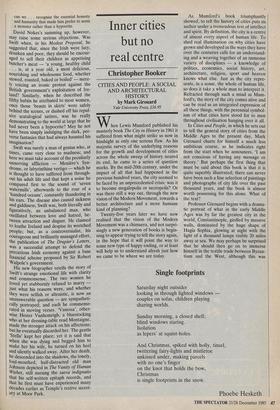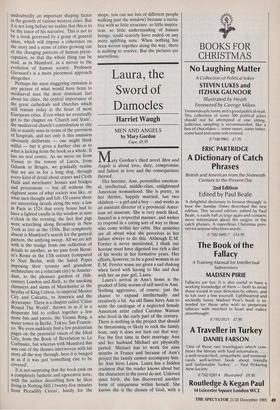Inner cities but no real centre
Christopher Booker
CITIES AND PEOPLE: A SOCIAL AND ARCHITECTURAL HISTORY by Mark Girouard
Yale University Press, L16.95
When Lewis Mumford published his masterly book The City in History in 1961 it suffered from what might strike us now in hindsight as only one serious flaw. As his majestic survey of the underlying reasons for the growth and development of cities across the whole sweep of history neared its end, he came to a series of question marks. By the mid-20th century, under the impact of all that had happened in the previous hundred years, the city seemed to be faced by an unprecedented crisis: was it to become megalopolis or necropolis? Or was there still a way out, through the new vision of the Modern Movement, towards a better architecture and a more humane kind of planning?
Twenty-five years later we have now realised that the vision of the Modern Movement was a chimaera, and not surpri- singly a new generation of books is begin- ning to appear trying to tell the story again, in the hope that it will point the way to some new type of happy ending, or at least will help us to understand afresh just how we came to be where we are today. As Mumford's book triumphantly showed, to tell the history of cities puts its author under a tremendous test of intellect and spirit. By definition, the city is a centre of almost every aspect of human life. To shed real illumination on why cities have grown and developed in the ways they have over the centuries calls for an understand- ing and a weaving together of an immense variety of disciplines — a knowledge of politics, economics, social history, art, architecture, religion, sport and heaven knows what else. Just as the city repre- sents, in a sense, the whole of human life, so does it take a whole man to interpret it. Refracted through such a mind as Mum- ford's, the story of the city comes alive and can be read as an integrated expression of all these things, with the perennial symbol- ism of what cities have stood for to men throughout civilisation hanging over it all.
In Cities and People, in which he sets out to tell the general story of cities from the Middle Ages to the present day, Mark Girouard charts for himself a much less ambitious course, as he indicates right from the start when he announces, 'I am not conscious of having any message or theory.' But perhaps the first thing that must be said about this book is that it is quite superbly illustrated; there can never have been such a fine selection of paintings and photographs of city life over the past thousand years, and the book is almost worth possessing for this alone. What of the text?
Professor Girouard begins with a drama- tic portrait of what in the early Middle Ages was by far the greatest city in the world, Constantinople, girdled by massive walls, dominated by the huge shape of Hagia Sophia, glowing at night with the light of a thousand lamps visible 20 miles away at sea. We may perhaps be surprised that he should then go on to immerse himself in the textile trade between Byzan- tium and the West, although this was undoubtedly an important shaping factor in the growth of various western cities. But i it is not long before we realise that this is to be the tenor of his narrative. This is not to be a book governed by a grasp of general ideas, which will impose a coherence on the story and a sense of cities growing out of the changing patterns of human preoc- cupation, so that the whole thing can be read, as in Mumford, as a mirror to the evolution of human society. Professor Girouard's is a more piecemeal approach altogether.
Perhaps the most staggering omission is any picture of what would have been to mediaeval man the most dominant fact about his cities, the central importance of the great cathedrals and churches which still remain today at the heart of most European cities. Even when we eventually get to the chapter on 'Church and State', the mediaeval church's contribution to city life is mainly seen in terms of the provision of hospitals, and not only is this omission obviously deliberate — one might think wilful — but it gives a further clue as to what is lacking from the book as a whole. It has no real centre. As we move on from Venice to the towers of Lucca, from Gdansk to Bruges, we gradually realise that we are in for a long slog, through every kind of detail about cranes and Cloth Halls and merchants' houses and bridges and processions — but all without the slightest sense of what society was like, or what men thought and felt. Of course there are interesting details along the way: a law in Paris in 1524 that every house had to have a lighted candle in the window at nine o'clock in the evening; the fact that pigs were scratching along Broadway in New York as late as the 1830s. But completely absent is Mumford's search for the general pattern, the unifying sweep. All we are left with is the trudge from one collection of details to another, as we pass from Berni- nes Rome in the 17th century (compared to Nazi Berlin, with the hated Popes Imposing their tyranny and grandiose architecture on a reluctant city) to Amster- dam, to the pleasure gardens of 18th- century London and Bath, to the smoking chimneys and slums of Manchester in the heyday of King Cotton, to imperial Mexico City and Calcutta, to America and the skyscraper. There is a chapter called 'Cities Round The World', thrown in as if in a desperate bid to collect together a few more bits and pieces, the Vienna Ring, a water tower in Berlin, Tokyo, San Francis- co. We even suddenly find a few pedestrian pages on the perennial vision of the Ideal City, from the Book of Revelation to Le Corbusier, but whereas with Mumford this was one of the themes interwoven with his story all the way through, here it is bunged in as if it was just 'something else to be covered'.
It is not surprising that the book ends on a completely bathetic and egocentric note, with the author describing how he likes living in Notting Hill (`twenty-five minutes from Piccadilly Circus', handy for the shops, you can see lots of different people walking past the window) because a narra- tive with so little structure, so little inspira- tion, so little understanding of human beings, could scarcely have ended on any more uplifting note. When nothing has been woven together along the way, there is nothing to resolve. But the pictures are marvellous.



















































































 Previous page
Previous page